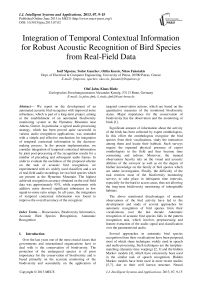Integration of Temporal Contextual Information for Robust Acoustic Recognition of Bird Species from Real-Field Data
Автор: Iosif Mporas, Todor Ganchev, Otilia Kocsis, Nikos Fakotakis, Olaf Jahn, Klaus Riede
Журнал: International Journal of Intelligent Systems and Applications(IJISA) @ijisa
Статья в выпуске: 7 vol.5, 2013 года.
Бесплатный доступ
We report on the development of an automated acoustic bird recognizer with improved noise robustness, which is part of a long-term project, aiming at the establishment of an automated biodiversity monitoring system at the Hymettus Mountain near Athens, Greece. In particular, a typical audio processing strategy, which has been proved quite successful in various audio recognition applications, was amended with a simple and effective mechanism for integration of temporal contextual information in the decision-making process. In the present implementation, we consider integration of temporal contextual information by joint post-processing of the recognition results for a number of preceding and subsequent audio frames. In order to evaluate the usefulness of the proposed scheme on the task of acoustic bird recognition, we experimented with six widely used classifiers and a set of real-field audio recordings for two bird species which are present at the Hymettus Mountain. The highest achieved recognition accuracy obtained on the real-field data was approximately 93%, while experiments with additive noise showed significant robustness in low signal-to-noise ratio setups. In all cases, the integration of temporal contextual information was found to improve the overall accuracy of the recognizer.
Bioacoustics, Biodiversity Informatics, Acoustic Bird Species Recognition, Automatic Recognition
Короткий адрес: https://sciup.org/15010438
IDR: 15010438
Список литературы Integration of Temporal Contextual Information for Robust Acoustic Recognition of Bird Species from Real-Field Data
- D.K. Dawson, M.G. Efford, “Bird population density estimated from acoustic signals,” Journal of Applied Ecology, vol. 46, 2009, pp. 1201–1209.
- S.E. Anderson, A.S. Dave, and D. Margoliash, “Template-based automatic recognition of birdsong syllables from continuous recordings,” J. Acoust. Soc. America, 100(2), pp. 1209-1219, Au-gust 1996.
- K. Ito, K. Mori, and S. Iwasaki, “Application of dynamic programming matching to classification of budgerigar contact calls,” J. Acoust. Soc. America, 100(6), pp. 3947-3956, December 1996.
- J.A. Kogan, and D. Margoliash, “Automated recognition of bird song elements from continuous recordings using dynamic time warping and hidden Markov models: A comparative study,” Journal of Acoust. Soc. America, 103(4), pp. 2185-2196, April 1998.
- V.M.. Trifa, A.N.G. Kirschel, and C.E. Taylor, “Automated species recognition of antbirds in a Mexican rainforest using hidden Markov models,” J. Acoust. Soc. America, 123(4), pp. 2424-2431, April 2008.
- P. Somervuo, A. Harma, and S. Fagerlund, “Parametric repre-sentations of bird sounds for automatic species recognition,” IEEE Transactions on Audio, Speech and Language Processing, vol. 14, no. 6, pp. 2252–2263, 2006.
- I. Agranat, “Automatically Identifying Animal Species from their Vocalizations,” Wildlife Acoustics, Inc., Concord, Massachusetts, March 2009.
- S.A. Selouani, M. Kardouchi, E. Hervet, and D. Roy, “Automatic birdsong recognition based on autoregressive timedelay neural networks,” In Congress on Computational Intelligence Methods and Applications, pp. 1–6, Istanbul, Turkey, 2005.
- A. L. Mcllraith and H. C. Card, “Birdsong recognition using backpropagation and multivariate statistics,” IEEE Transactions on Signal Processing, vol. 45, no. 11, pp. 2740–2748, 1997.
- C. Kwan, K.C. Ho, G. Mei, et al., “An automated acoustic system to monitor and classify birds,” EURASIP J. on Applied Signal Processing, vol. 2006, Article ID 96706, 19 pages, 2006.
- H. Tyagi, R.M. Hegde, H.A. Murthy, and A. Prabhakar, “Automatic identification of bird calls using spectral ensemble average voiceprints,” In Proc. of the 13th European Signal Processing Conference, Florence, Italy, September 2006.
- S. Fagerlund, “Bird Species Recognition Using Support Vector Machines,” EURASIP Journal on Advances in Signal Processing, Vol. 2007, Article ID 38637, 8 pages, doi:10.1155/2007/38637.
- E. Vilches, I.A. Escobar, E.E. Vallejo, and C.E. Taylor, “Data mining applied to acoustic bird species recognition,” In Proceedings of the 18th International Conference on Pattern Recognition, vol. 3, pp. 400–403, Hong Kong, August 2006.
- A. Harma, “Automatic identification of bird species based on sinusoidalmodelling of syllables,” In Proceedings of IEEE Interna-tional Conference on Acoustics, Speech, and Signal Processing, vol. 5, pp. 545–548, Hong Kong, April 2003.
- P. Somervuo and A. Harma, “Bird song recognition based on syllable pair histograms,” In Proceedings of IEEE International Conference on Acoustics, Speech, and Signal Processing, vol. 5, pp. 825–828, Montreal, Canada, May 2004.
- C.H. Lee, Y.K. Lee, and R.Z. Huang, “Automatic Recognition of Bird Songs Using Cepstral Coefficients,” Journal of Information Technology and Applications, vol. 1, no. 1, pp. 17-23, May 2006.
- P. Jancovic and M. Kokuer, “Automatic Detection and Recognition of Tonal Bird Sounds in Noisy Environments,” EURASIP Journal on Advances in Signal Processing, Vol. 2011, Article ID 982936, 10 pages, doi: 10.1155/2011/982936.
- S. Young, G. Evermann, M. Gales, T. Hain, D. Kershaw, X. Liu, G. Moore, J. Odell, D. Ollason, D. Povey, V. Valtchev, and P. Woodland, The HTK book (for HTK Version 3.4), Cambridge University Engineering Department.
- F. Eyben, M. Wollmer, and B. Schuller, “OpenEAR - intro-ducing the Munich open-source emotion and affect recognition toolkit,” In Proc. of the 4th International HUMAINE Association Conference on Affective Computing and Intelligent Interaction (ACII 2009).
- D. Aha, D. Kibler, "Instance-based learning algorithms", Machine Learning, 6 (1991), pp. 37–66.
- T.M. Mitchell, Machine Learning, McGraw-Hill International Editions (1997).
- S.S. KeerthiS.S., S.K. Shevade, C. Bhattacharyya, K.R.K. Murthy, "Improvements to Platt's SMO algorithm for SVM classifier design, Neural Computation, 13 (3) (2001), pp. 637–649.
- R. Quinlan, C4.5: Programs for Machine Learning, Morgan Kaufmann Publishers, San Mateo, CA (1993).
- H.I. Witten, and E. Frank. Data Mining: practical machine learning tools and techniques. Morgan Kaufmann Publishing.
- Yoav Freund, Robert E. Schapire: Experiments with a new boosting algorithm. In: Thirteenth International Conference on Machine Learning, San Francisco, 148-156, 1996.
- Leo Breiman (1996). Bagging predictors. Machine Learning. 24(2):123-140.


